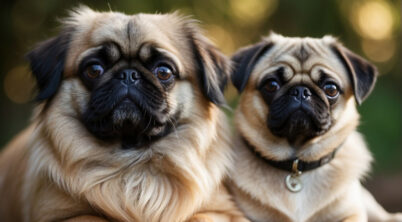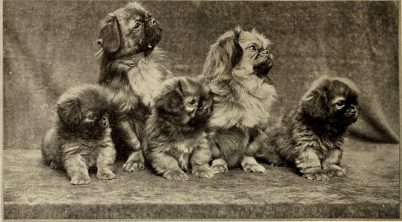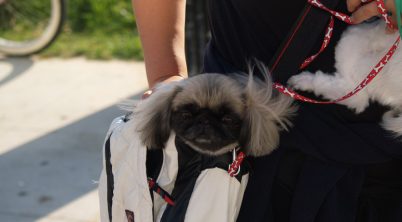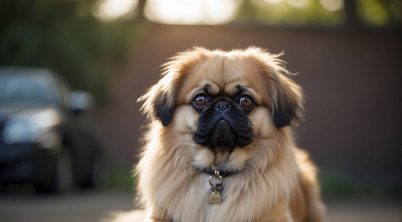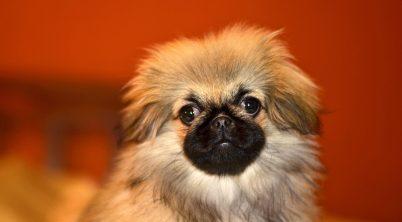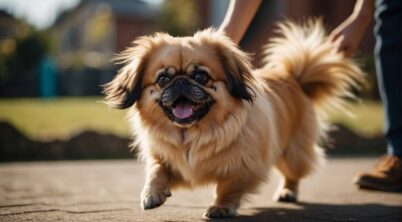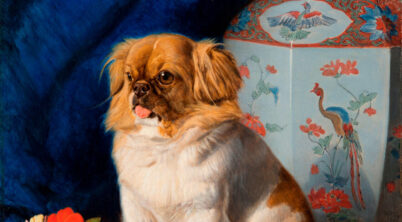The Pekingese is a toy dog breed with a rich history closely linked to Chinese royalty. As a cherished companion of the imperial family, this small canine carries itself with an air of dignity that reflects its noble background. Originating from China, the breed is characterized by its distinct physical appearance, which includes a flat face, large expressive eyes, and a luxurious mane of fur that resembles the look of a lion.
In terms of temperament, the Pekingese possesses a self-assured confidence that belies its small size. These dogs are known for their loyalty and often display an affectionate nature with their owners. Despite their regal origins, Pekingese can also exhibit a playful side, although they maintain a watchful demeanor, serving as vigilant watchdogs in the home.
Physically, the breed is compact and well-built under their thick coats, which can come in various color combinations. The distinctive rolling gait of the Pekingese is a result of its unique body structure with a short, broad build and bowed limbs. As a toy breed, the Pekingese is small in size, yet they have a sturdy, surprisingly heavy presence when picked up. The dramatic fur around their neck and shoulders adds to their striking appearance and has contributed to their enduring popularity as both companion animals and show dogs.
Table of Contents
Origin and History
The Pekingese breed boasts an illustrious provenance rooted in ancient China, closely aligned with Chinese royalty and deeply embedded within the cultural fabric of its origins. Recognized for its association with religious myth and imperial significance, the breed has transitioned through significant historical events, including the Opium Wars, and crossed international lines to Western societies.
Ancient Chinese Roots
The Pekingese, affectionately known as the “lion dog” or “sleeve dog,” hails from the tapestry of ancient Chinese culture. It is said that the breed mirrors Chinese guardian lion statues, fostering a belief that the Pekingese is an earthly manifestation of the mythical lion of Buddha. Chinese royalty favored these dogs for their lion-like resemblance, which symbolized the link between the spiritual and the regal. As companions of the imperial class, the Pekingese enjoyed a place of reverence and privilege. It was held in such high esteem that the penalty for theft of a Pekingese was death.
- Country of Origin: China
- Roles: Companion, symbol of royalty and religion
- Nickname(s): Lion Dog, Sleeve Dog
British Influence and Kennel Clubs
The British came to know the Pekingese during the Second Opium War in the mid-19th century. With the looting of the Summer Palace, several Pekingese were brought back to Britain as spoils of war, one of which was presented to Queen Victoria, thus earning the breed royal patronage in the West. Through British influence, the breed’s presence expanded, and established kennel clubs began to recognize it. The American Kennel Club (AKC) registered its first Pekingese in 1906. Not long after, the Pekingese Club of America was founded in 1909, anchoring the breed’s status within canine aristocracy on both sides of the Atlantic.
- First AKC Registration: 1906
- Pekingese Club of America Established: 1909
- Connection to British Royalty: Queen Victoria’s Pekingese, Looty
By the late 19th and early 20th centuries, the breed had become a fashionable status symbol among the upper class, a testament to its rich history and enduring allure.
Physical Description
The Pekingese is a toy breed notable for its regal bearing, compact build, and distinctive physical characteristics.
Size and Weight
- Height: 6 to 9 inches at the shoulder
- Weight: Up to 14 pounds
Coat and Color
The Pekingese sports a double-coat that can be long and luxuriant, embodying various colors such as red, black, white, cream, sable, fawn, gray, and tan. Occasionally, specific coat patterns include a distinctive black mask.
Facial Features
This breed is brachycephalic, with a flat face and a short, broad snout. The Pekingese has large, expressive eyes and ears that lie close to the head. The tail is typically carried over the back in a curl, enhancing its noble appearance.
Personality and Temperament
The Pekingese breed exhibits a distinguished personality marked by a combination of courage, self-esteem, and independence. They are affectionate and loyal, making them excellent companions in family settings.
Behavioral Traits
Temperament: The Pekingese has a bold and confident temperament. They are known to be quite intelligent and alert, always aware of their surroundings. Despite their small size, Pekingese dogs have strong personalities and may exhibit stubborn tendencies.
- Energy Level: Usually moderate; they enjoy playfulness but do not require extensive exercise.
- Watchdog Capability: They are excellent watchdogs as they are protective and will sound the alarm when strangers approach.
Training: Due to their independent nature, Pekingese may be seen as stubborn during training. However, with patience and positive reinforcement, they can learn and respond well. Early socialization is crucial to ensure they become well-adapted adults.
Social and Family Interaction
Family: Pekingese can be extremely loving and loyal to their family members. They thrive on affection and often form strong bonds with their owners.
Social: While Pekingese can be affectionate, they may take time to warm up to new people or pets. Appropriate socialization practices are important from a young age to foster a well-rounded and sociable character.
Independence: Owners might note their Pekingese exhibiting an independent streak. This independence is a trait to be respected; it requires owners to be understanding and adaptable in their interactions with the breed.
Regarding social interaction, they are capable of adapting to a variety of situations when properly socialized but may prefer a more serene environment reflective of their regal heritage. They can be playful and sweet with family but are often reserved around strangers.
Care and Management
Proper care and management of Pekingese dogs are crucial for their wellbeing. Owners should focus on comprehensive grooming practices and adjusting exercise and training to meet the breed’s needs.
Health and Grooming
Pekingese have a long, luxurious coat that requires regular grooming to prevent matting and reduce shedding. Brushing a few times a week is essential to maintain a healthy coat, and using a fine-toothed comb around the facial area can prevent fur from obstructing their large eyes. Shedding occurs seasonally, and more frequent grooming during these periods can help manage loose hair.
When it comes to health, the breed is susceptible to certain conditions like progressive retinal atrophy and respiratory issues due to their short snouts which can cause snoring and sometimes lead to overheating. Regular veterinary check-ups are important to catch any health concerns early.
Exercise and Training
Pekingese dogs have moderate exercise needs despite their small size. They require daily physical activity to keep them fit and prevent obesity, but the intensity should be moderate to avoid issues with overheating. Two 20-minute walks per day or play sessions in a cool environment are ideal to meet their exercise requirements.
Training a Pekingese can be challenging as they may exhibit an independent streak. Owners should employ positive reinforcement techniques, using treats and praise to encourage good behavior and enhance trainability. Consistency and patience are key. They are playful by nature, and incorporating play into training sessions can boost their energy level and playfulness, making sessions more enjoyable and productive.
Breed Considerations
In considering the Pekingese, one must be cognizant of the breed’s unique attributes and requirements, from their sophistication as a former member of Chinese royalty to their specific needs as a brachycephalic toy breed.
Adaptation to Living Conditions
The Pekingese is a toy breed that adapts well to indoor living, making them suitable companions for families or individuals residing in apartments and houses alike. Though compact, they display a regal and lion-like appearance which is complemented by their distinctive rolling gait. Due to their history as lap dogs for Chinese nobility, they thrive in environments where they can enjoy close companionship and are not well-suited for outdoor living.
- Size: Though small, they require space to roam and display their characteristic gait.
- Climate Adaptation: Their thick double coat can make them prone to overheating, especially in warm climates, making climate control important.
Breed Specific Challenges
Pekingese are brachycephalic due to their short snout, a feature that presents several health challenges:
- Respiratory Issues: They may struggle with breathing and are prone to snoring. Owners should monitor their respiratory health closely and avoid excessive exercise.
- Eye Concerns: Their large, prominent eyes can be susceptible to injuries and progressive retinal atrophy. Regular check-ups with a vet are necessary.
- Heat Sensitivity: They are at an increased risk of overheating. Encourage light exercise and provide a cool environment.
In addition, Pekingese require regular grooming to maintain their sophisticated, lion-like coat and prevent matting. Prospective owners should seek a reputable breeder to ensure they are aware of and prepared for these breed-specific challenges.
Cultural and Historical Significance
The Pekingese breed boasts a rich heritage interwoven with Chinese culture and royalty. This breed’s historical significance is rooted in its origin from the imperial courts of China and deep connections with Buddhist symbolism.
Influence on Popular Culture
The Pekingese has made occasional appearances in popular culture, their distinct lion-like appearance capturing the interest of artists and storytellers. This breed is often depicted as the quintessence of regal elegance, reflecting their historical status as the chosen companions of Chinese royalty. While direct references in mainstream media are sparse, the Pekingese influence is notable in the realms of art and literature, where they symbolize both opulence and cultural heritage.
Historical Anecdotes
- Origin: The Pekingese originates from the royal courts of China, where they were guarded and bred by Chinese royalty over 2,000 years ago.
- Royalty: This breed was so esteemed that theft of a Pekingese was once punishable by death, underlining their value and exclusivity to the imperial family.
- British Influence: The breed became known to the Western world after the Second Opium War when British troops invaded the Forbidden City and returned with several of these dogs.
- Queen Victoria: Among the looted treasures, the British brought a Pekingese to Queen Victoria, who named him “Looty,” marking the breed’s introduction to Europe.
- Buddhism: The Pekingese is considered a reflection of the lion, an animal with significant meaning in Buddhist tradition, believed to represent the Buddha himself.
- Suicide: During the Second Opium War in 1860, an aunt of the Chinese emperor committed suicide to avoid the humiliation of capture, with her Pekingese by her side, indicating the breed’s closeness to Chinese royalty even in times of crisis.
By consistently serving as the cherished companions of Chinese emperors and empresses, Pekingese have fostered a cultural legacy steeped in history and imbued with spirituality.
* Banner photo by DiasSoares, cropped | Some rights reserved

